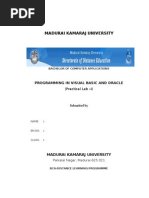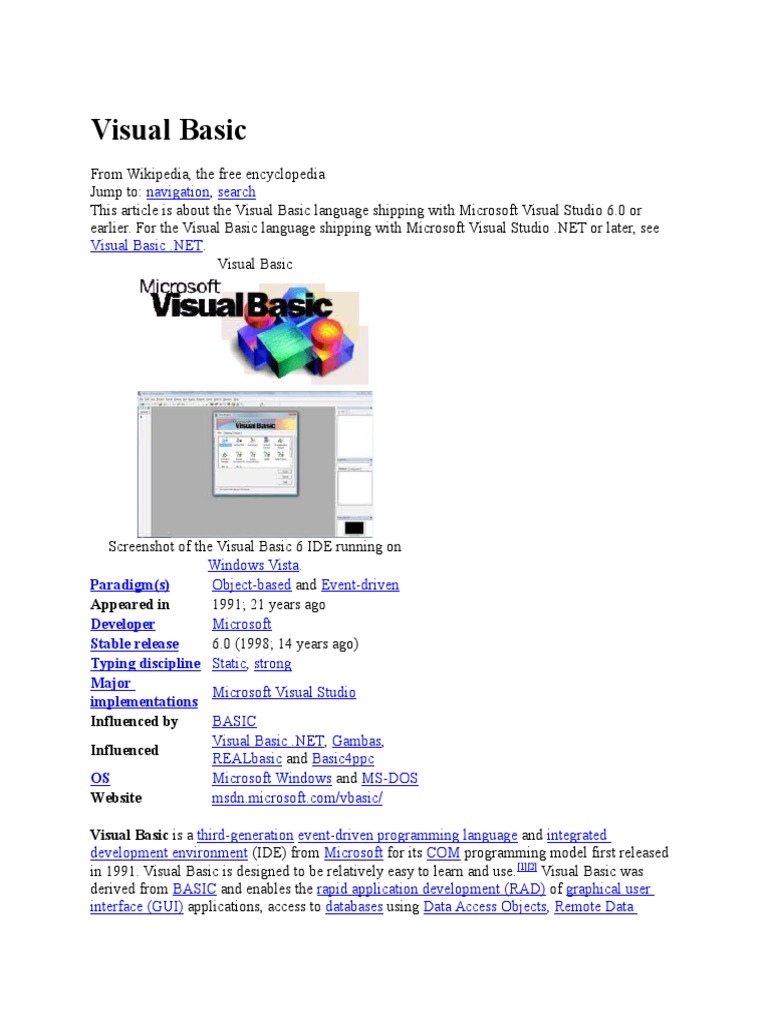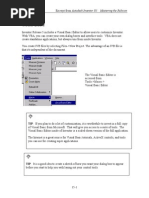Vb Net 2008 Tutorial Pdf Bahasa Indonesia
- Vb Net 2008 Tutorial Pdf Bahasa Indonesia Perguruan Tinggi
- Vb Net 2008 Tutorial Pdf Bahasa Indonesia Kelas 10
Apakah dalam Visual Basic mempunyai operator.?? Kalau ia coba sebutkan dan jelaskan!!2. Ada berapa fungsi kah pemrograman dalam Visual Basic.??
Sebutkan dan jelaskan!!3. Pada tahun berapakah Visual Basic mulai dikenalkan.??4. Sebutkan definisi dari Visual Basic itu sendiri.??5. Apakah keunggulan dari pemrograman Visual Basic.??6. Ceritakan secara singkat sejarah Visual Basic.??7.

Apakah guna Visual Basic dalam kehidupan sosial masyarak saat ini.??8. Apakah perbedaan antara pemrograman Visual Basic dengan pemrograman Turbo Pascal.??9.
Apakah kita bisa membuat aplikasi dari program Visual Basic, seperti aplikasi anti virus contohnya.??10. Apakah perbedaan tipe data dalam bahasa pemrograman Turbo Pascal dengan bahasa pemrograman Visual Basic.?? Like the programming language, Visual Basic was designed to be easily learned and used by beginner programmers.
Tutorial ASP.Net Lengkap Bahasa Indonesia PDF (Download Pengenalan ASP.Net Web API) Download Lengkap ASP.NET - Pada ebook ini akan dikenalkan tentang ASP.NET Web API dengan bantuan tool Visual Studio 2013. Selain itu juga akan diberikan contoh-contoh penggunaannya serta pemanfaatannya pada aplikasi web dan mobile. Akhir kata, selamat membaca.
Vb Net 2008 Tutorial Pdf Bahasa Indonesia Perguruan Tinggi
The language not only allows programmers to create simple applications, but can also develop complex applications. Programming in VB is a combination of visually arranging or on a, specifying attributes and actions of those components, and writing additional lines of for more functionality. Since default attributes and actions are defined for the components, a simple program can be created without the programmer having to write many lines of code.
Performance problems were experienced by earlier versions, but with faster computers and native code compilation this has become less of an issue. Forms are created using techniques. A tool is used to place controls (e.g., text boxes, buttons, etc.) on the form (window).
Vb Net 2008 Tutorial Pdf Bahasa Indonesia Kelas 10
Controls have and associated with them. Default values are provided when the control is created, but may be changed by the programmer. Many attribute values can be modified during run time based on user actions or changes in the environment, providing a dynamic application. For example, code can be inserted into the form resize event handler to reposition a control so that it remains centered on the form, expands to fill up the form, etc. By inserting code into the event handler for a keypress in a text box, the program can automatically translate the case of the text being entered, or even prevent certain characters from being inserted. Visual Basic can create executables (EXE files), or DLL files, but is primarily used to develop Windows applications and to interface database systems.
Dialog boxes with less functionality can be used to provide pop-up capabilities. Controls provide the basic functionality of the application, while programmers can insert additional logic within the appropriate event handlers. For example, a drop-down combination box will automatically display its list and allow the user to select any element. An event handler is called when an item is selected, which can then execute additional code created by the programmer to perform some action based on which element was selected, such as populating a related list.
The language is using, has a large library of utility objects, and has basic. Since the more common components are included in the default project template, the programmer seldom needs to specify additional libraries. Unlike many other programming languages, Visual Basic is generally not case sensitive, although it will transform into a standard case configuration and force the case of variable names to conform to the case of the entry within the symbol table.
String comparisons are case sensitive by default, but can be made case insensitive if so desired. Visual Basic has the following traits which differ from C-derived languages:. Multiple assignment available in C language is not possible.
A = B = C does not imply that the values of A, B and C are equal. The boolean result of 'Is B = C?' Is stored in A.
The result stored in A could therefore be false(0) or true(-1). constant True has numeric value −1. This is because the Boolean data type is stored as a 16-bit signed integer. In this construct −1 evaluates to 16 binary 1s (the Boolean value True), and 0 as 16 0s (the Boolean value False). This is apparent when performing a Not operation on a 16 bit signed integer value 0 which will return the integer value −1, in other words True = Not False.
This inherent functionality becomes especially useful when performing logical operations on the individual bits of an integer such as And, Or, Xor and Not. This definition of True is also consistent with BASIC since the early 1970s Microsoft BASIC implementation and is also related to the characteristics of CPU instructions at the time. Logical and bitwise operators are unified. This is unlike some C-derived languages (such as ), which have separate logical and bitwise operators. This again is a traditional feature of BASIC. Variable base. Arrays are declared by specifying the upper and lower bounds in a way similar to.
It is also possible to use the Option Base statement to set the default lower bound. Use of the Option Base statement can lead to confusion when reading Visual Basic code and is best avoided by always explicitly specifying the lower bound of the array. This lower bound is not limited to 0 or 1, because it can also be set by declaration. In this way, both the lower and upper bounds are programmable. In more subscript-limited languages, the lower bound of the array is not variable. This uncommon trait does exist in but not in.OPTION BASE was introduced by ANSI, with the standard for ANSI Minimal BASIC in the late 1970s. Relatively strong integration with the and the.
The native types for strings and arrays are the dedicated COM types, BSTR and SAFEARRAY. as the default behavior when converting real numbers to integers with the Round function.? Round(2.5, 0) gives 2,?
Round(3.5, 0) gives 4. Integers are automatically promoted to reals in expressions involving the normal division operator ( /) so that division of an odd integer by an even integer produces the intuitively correct result. There is a specific integer divide operator ( ) which does truncate. By default, if a variable has not been declared or if no type declaration character is specified, the variable is of type.
However this can be changed with Deftype statements such as DefInt, DefBool, DefVar, DefObj, DefStr. There are 12 Deftype statements in total offered by Visual Basic 6.0. The default type may be overridden for a specific declaration by using a special suffix character on the variable name ( # for Double,! for Single, & for Long,% for Integer, $ for String, and @ for Currency) or using the key phrase As (type). VB can also be set in a mode that only explicitly declared variables can be used with the command Option Explicit. History. The Ruby interface generator provided the 'visual' part of Visual Basic and this was combined with the 'EB' Embedded BASIC engine designed for Microsoft's abandoned 'Omega' database system. Ruby also provided the ability to load containing additional controls (then called 'gizmos'), which later became the interface.
Timeline. Project 'Thunder' was initiated.
Visual Basic 1.0 (May ) was released for Windows at the Comdex/Windows World trade show in Atlanta, Georgia. Visual Basic 1.0 for was released in September.
The language itself was not quite compatible with Visual Basic for Windows, as it was actually the next version of Microsoft's DOS-based BASIC compilers, and BASIC Professional Development System. The interface used a, using characters to simulate the appearance of a. Visual Basic for MS-DOS. Visual Basic 2.0 was released in November.


The programming environment was easier to use, and its speed was improved. Notably, forms became instantiable objects, thus laying the foundational concepts of class modules as were later offered in VB4. Visual Basic 3.0 was released in the summer of and came in Standard and Professional versions. VB3 included version 1.1 of the that could read and write Jet (or Access) 1.x databases. Visual Basic 4.0 (August ) was the first version that could create as well as Windows programs. It also introduced the ability to write non-GUI classes in Visual Basic.
Incompatibilities between different releases of VB4 caused installation and operation problems. While previous versions of Visual Basic had used VBX controls, Visual Basic now used OLE controls (with files names ending in.OCX) instead. These were later to be named ActiveX controls. With version 5.0 (February ), Microsoft released Visual Basic exclusively for versions of Windows. Programmers who preferred to write 16-bit programs were able to import programs written in Visual Basic 4.0 to Visual Basic 5.0, and Visual Basic 5.0 programs can easily be converted with Visual Basic 4.0. Visual Basic 5.0 also introduced the ability to create custom user controls, as well as the ability to compile to native Windows executable code, speeding up calculation-intensive code execution. A free, downloadable Control Creation Edition was also released for creation of.
It was also used as an introductory form of Visual Basic: a regular.exe project could be created and run in the IDE, but not compiled. Visual Basic 6.0 (Mid ) improved in a number of areas including the ability to create web-based applications. VB6 has entered Microsoft's 'non-supported phase' as of March. Although the Visual Basic 6.0 development environment is no longer supported, the runtime is supported on Windows Vista, Windows Server 2008 and Windows 7. Mainstream Support for Microsoft Visual Basic 6.0 ended on March 31, 2005.
Extended support ended in March 2008. In response, the Visual Basic user community expressed its grave concern and lobbied users to sign a petition to keep the product alive. Microsoft has so far refused to change their position on the matter. (but see ) Ironically, around this time (2005), it was exposed that Microsoft's new anti-spyware offering, (part of the purchase), was coded in Visual Basic 6.0. Its replacement, Windows Defender, was rewritten as C code. Some of the derived languages are:. (VBA) is included in many Microsoft applications , and also in many third-party products like, and Business Objects Desktop Intelligence.
There are small inconsistencies in the way VBA is implemented in different applications, but it is largely the same language as VB6 and uses the same runtime library. is the default language for. It can be used in scripting and client-side scripting. Although it resembles VB in syntax, it is a separate language and it is executed by vbscript.dll as opposed to the VB runtime. ASP and VBScript should not be confused with which uses the for compiled web pages. is Microsoft's designated successor to Visual Basic 6.0, and is part of Microsoft's platform.
Visual Basic.Net compiles and runs using the.NET Framework. It is not with VB6. An automated conversion tool exists, but fully automated conversion for most projects is impossible. is a Visual Basic compatible interpreter included in suite, developed by. is a Visual Basic inspired programming language.
It is not a clone of Visual Basic, but it does have the ability to convert Visual Basic programs to Gambas.